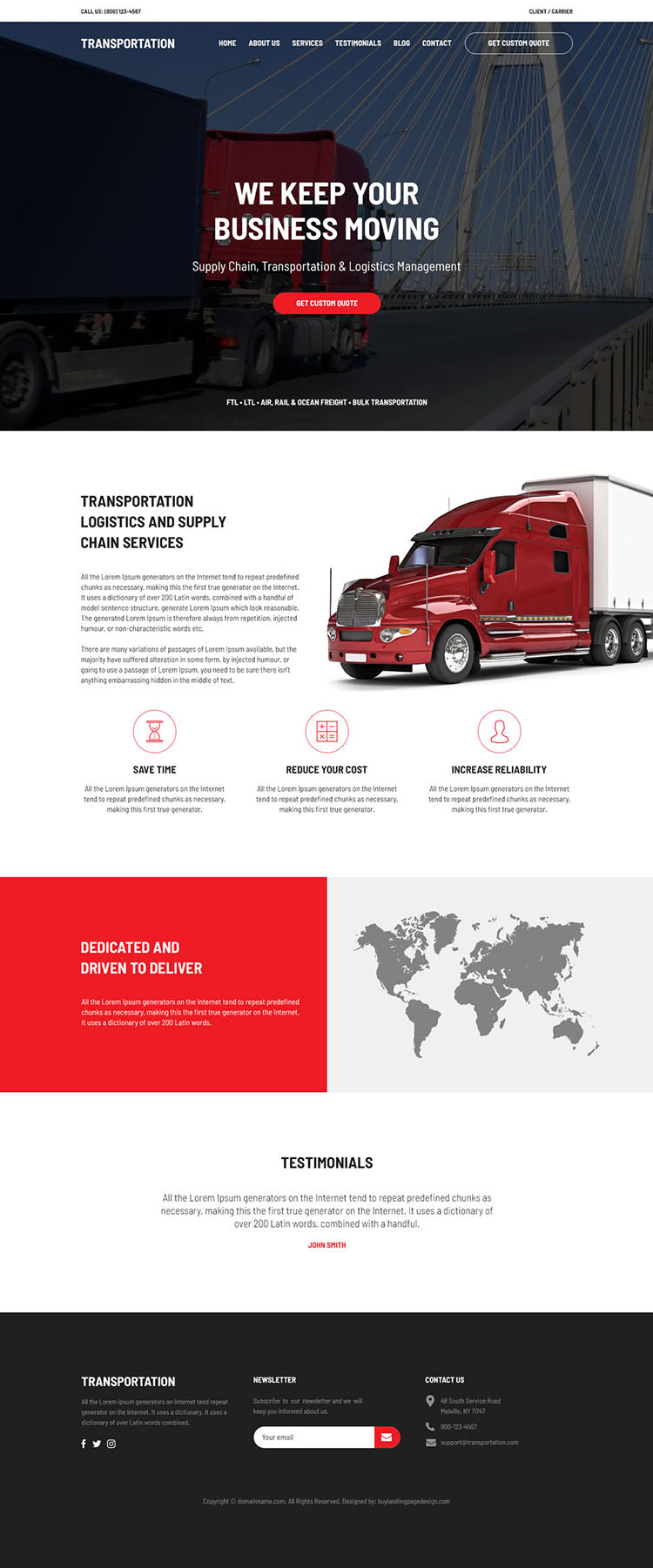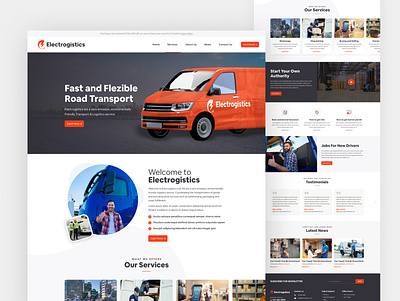Elevate Your Brand With Tailored Transport Website Design for Seamless Customer Experience
In today's competitive landscape, the significance of a tailored transportation internet design can not be overemphasized. A well-crafted website not only offers as a digital shop yet also plays a critical function in shaping individual experience and boosting brand identity.
Relevance of Customized Website Design
In the affordable landscape of transportation services, standing out is essential, and tailored web design plays an essential duty in attaining this differentiation. A tailored internet design not only improves a business's on-line visibility but also shows its special brand name identification, which is necessary in bring in and retaining clients - transportation web design. This approach allows companies to produce a web site that successfully connects their solutions, values, and mission, setting them in addition to competitors

Furthermore, a properly designed website can substantially boost online search engine presence, attracting organic web traffic and possible customers. Customization likewise enables the integration of analytics tools, allowing firms to monitor user habits and adapt their methods as necessary. Inevitably, spending in tailored website design is not just about looks; it is a tactical decision that boosts brand name acknowledgment, customer engagement, and general company growth in the transport industry.
Key Elements of Individual Experience
Customer experience (UX) acts as the foundation of reliable internet style, directly affecting just how site visitors connect with a transport firm's internet site. Numerous vital components add to an optimum UX, starting with instinctive navigating. A well-structured menu enables users to find details promptly, minimizing aggravation and enhancing complete satisfaction.
One more crucial aspect is filling rate; web sites should perform successfully to preserve individuals' attention. A hold-up of simply a couple of seconds can lead to greater bounce rates. Additionally, aesthetic pecking order plays an important role, leading individuals through content and ensuring that one of the most essential information attracts attention.
Material readability is important, as it influences exactly how conveniently individuals can absorb info. Clear typography, ideal typeface sizes, and sufficient contrast enhance clarity. Furthermore, including engaging visuals can improve the user experience, making the website much more enticing and helpful.
Finally, access can not be ignored. Designing for all individuals, consisting of those with disabilities, makes sure inclusivity and widens the audience. By concentrating on these vital elements of UX, transportation firms can develop a website that not only draws in site visitors yet also fosters interaction and commitment.

Benefits of Responsive Layouts
Regularly, businesses forget the relevance of responsive layouts in website design, yet reference they are vital for accommodating the diverse range of devices customers utilize today. A receptive layout ensures that your website adapts seamlessly to various display sizes, giving an optimal viewing experience throughout smart devices, tablet computers, and desktops (transportation web design). This flexibility enhances customer engagement, as visitors are most likely to remain on a website that is easy to browse, no matter of the gadget they use
Additionally, receptive designs add to boosted search engine optimization (SEO) Internet search engine like Google focus on mobile-friendly websites in their rankings, which indicates that taking on a responsive design can bring about you could look here increased exposure and greater website traffic. In addition, maintaining a single responsive site minimizes the demand for different mobile versions, streamlining site management and lessening upkeep prices.
An additional trick benefit is the enhancement of brand trustworthiness. An expert, well-structured internet site that executes consistently across devices fosters count on among users. Receptive layouts are future-proof; as brand-new devices arise, your website remains adaptable, guaranteeing a long lasting visibility in an ever-evolving digital landscape. Accepting receptive designs is crucial for any business intending to boost its on the internet existence and user satisfaction.
Enhancing Brand Identification
A strong brand name identity is essential for any type of transport business wanting to stand out in an affordable marketplace. It offers as the foundation whereupon customer assumptions are built, affecting their trust and loyalty. transportation web design. A well-designed web site can considerably boost this identity, supplying a visual representation of the brand name's values, mission, and services
To successfully convey brand identity, transport website design need to incorporate constant components such as logo designs, color pattern, and typography. These aspects should resonate with the target market, creating a psychological link that fosters recognition and recall. In addition, the images used on the site must mirror the essence of the brand-- whether it's dependability, technology, or rate.
Additionally, storytelling through material can additionally enhance brand name identity. Engaging narratives regarding the company's background, worths, and consumer success tales can produce an extra extensive link with potential clients. By integrating these essential style aspects and narration techniques, transport organizations can craft a cohesive and engaging online existence that not only catches interest however likewise develops long lasting connections with their customers. In doing so, they elevate their brand identity, guaranteeing it continues to be remarkable in a jampacked market.

Approaches for Reliable Navigating
Efficient navigating is crucial for any type of transport internet site, as it straight influences user experience and interaction. This permits customers to locate required details promptly.
Incorporating a search function improves navigating better, enabling users to locate certain information efficiently. Additionally, breadcrumb navigation is helpful as it provides users with context about their current place within the site, making it much easier to backtrack if required.
Utilizing a responsive design is also crucial, ensuring that navigating continues to be user-friendly across devices, from desktop computers to mobile phones. Consistency in navigation elements, such as switches and links, promotes knowledge, which can lead to boosted individual retention.
Lastly, think about carrying out a sticky food selection that stays available as users scroll down the web page. This keeps vital navigation options within reach, boosting use. By concentrating on these techniques, transportation sites can develop a seamless navigation experience that cultivates individual interaction and contentment.
Final Thought
